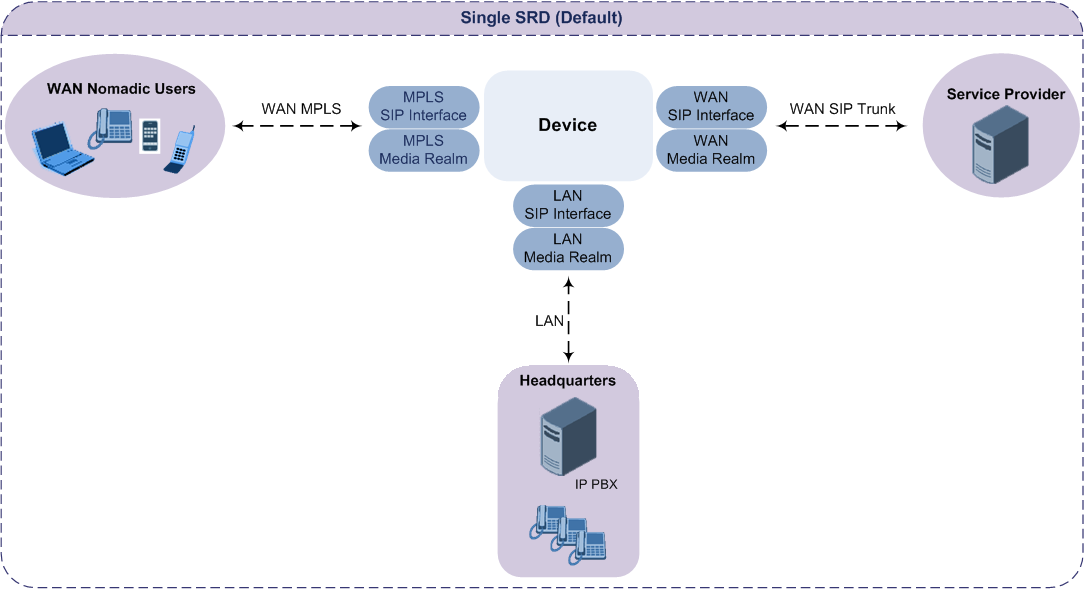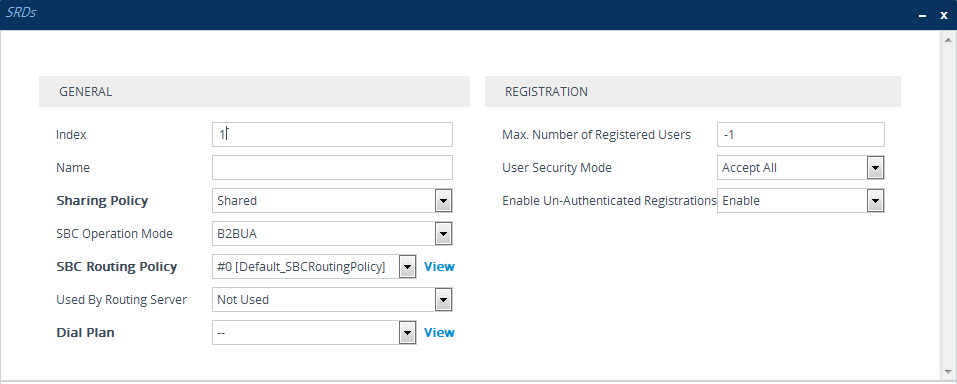Configuring SRDs
The SRDs table lets you configure up to
As the device is shipped with a default SRD ("DefaultSRD" at Index 0), if your deployment requires only one SRD, you can use the default SRD instead of creating a new one. When only one SRD is employed and you create other related configuration entities (e.g., SIP Interfaces), the default SRD is automatically assigned to the new configuration entity. Therefore, when employing a single-SRD configuration topology, there is no need to handle SRD configuration (i.e., transparent).
You can assign SRDs to the following configuration entities:
| ■ | SIP Interface (mandatory) - see Configuring SIP Interfaces |
| ■ | IP Group (mandatory) - see Configuring IP Groups |
| ■ | Proxy Set (mandatory) - see Configuring Proxy Sets |
| ■ | (SBC application only) Classification rule - see Configuring Classification Rules |
As mentioned previously, if you use only a single SRD, the device automatically assigns it to the above-listed configuration entities.
As each SIP Interface defines a different Layer-3 network (see Configuring SIP Interfaces for more information) on which to route or receive calls and as you can assign multiple SIP Interfaces to the same SRD, for most deployment scenarios (even for multiple Layer-3 network environments), you only need to employ a single SRD to represent your VoIP network (Layer 5). For example, if your VoIP deployment consists of an corporate IP PBX (LAN), a SIP Trunk (WAN), and far-end users (WAN), you would only need a single SRD. The single SRD would be assigned to three different SIP Interfaces, where each SIP Interface would represent a specific Layer-3 network (IP PBX, SIP Trunk, or far-end users) in your environment. The following figure provides an example of such a deployment:

| ● | It is recommended to use a single-SRD configuration topology, unless you are deploying the device in a multi-tenant environment, in which case multiple SRDs are required. |
| ● | Each SIP Interface, Proxy Set, and IP Group can be associated with only one SRD. |
| ● | If you have upgraded your device to Version 7.0 and your device was configured with multiple SRDs but not operating in a multi-tenant environment, it is recommended to gradually change your configuration to a single SRD topology. |
| ● | If you upgrade the device from an earlier release to Version 7.0, your previous SRD configuration is fully preserved regarding functionality. The same number of SRDs is maintained, but the configuration elements are changed to reflect the configuration topology of Version 7.0. Below are the main changes in configuration topology when upgrading to Version 7.0: |
| ✔ | The SIP Interface replaces the associated SRD in several tables (due to support for multiple SIP Interfaces per SRD). |
| ✔ | Some fields in the SRDs table were duplicated or moved to the SIP Interfaces table. |
| ✔ | Indices used for associating configuration entities in tables are changed to row pointers (using the entity's name). |
| ✔ | Some tables are now associated (mandatory) with an SRD (SIP Interface, IP Group, Proxy Set, and Classification). |
| ✔ | Some fields used for associating configuration entities in tables now have a value of Any to distinguish between Any and None (deleted entity or not associated). |
The following procedure describes how to configure SRDs through the Web interface. You can also configure it through ini file [SRD] or CLI (configure voip > srd).
| ➢ | To configure an SRD: |
| 1. | Open the SRDs table (Setup menu > Signaling & Media tab > Core Entities folder > SRDs). |
| 2. | Click New; the following dialog box appears: |

| 3. | Configure an SRD according to the parameters described in the table below. |
| 4. | Click Apply. |
SRDs table Parameter Descriptions
|
Parameter |
Description |
||||||||||||||||||||||||
|---|---|---|---|---|---|---|---|---|---|---|---|---|---|---|---|---|---|---|---|---|---|---|---|---|---|
| General | |||||||||||||||||||||||||
|
'Index' [Index] |
Defines an index for the new table row. Note: Each row must be configured with a unique index. |
||||||||||||||||||||||||
|
'Name' name [Name] |
Defines a descriptive name, which is used when associating the row in other tables. The valid value can be a string of up to 40 characters. Note:
|
||||||||||||||||||||||||
|
'Sharing Policy' type [SharingPolicy] |
Defines the sharing policy of the SRD, which determines whether the SRD shares its SIP resources (SIP Interfaces, Proxy Sets, and IP Groups) with all other SRDs (Shared and Isolated).
For more information on SRD Sharing Policy, see Multiple SRDs for Multi-tenant Deployments. |
||||||||||||||||||||||||
|
'SBC Operation Mode' sbc-operation-mode [SBCOperationMode] |
Defines the device's operational mode for the SRD.
For more information on B2BUA and Stateful Proxy modes, see B2BUA and Stateful Proxy Operating Modes. Note:
|
||||||||||||||||||||||||
|
'SBC Routing Policy' sbc-routing-policy-name [SBCRoutingPolicyName] |
Assigns a Routing Policy to the SRD. By default, no value is defined if you have configured multiple Routing Policies. If you have configured only one Routing Policy, the device assigns it to the SRD by default. For more information on Routing Policies, see Configuring SBC Routing Policy Rules. Note:
|
||||||||||||||||||||||||
|
'Used By Routing Server' used-by-routing-server [UsedByRoutingServer] |
Enables the SRD to be used by a third-party routing server or ARM for call routing decisions.
For more information on the third-party routing server or ARM feature, see Centralized Third-Party Routing Server. |
||||||||||||||||||||||||
|
'Dial Plan' sbc-dial-plan-name [SBCDialPlanName] |
Assigns a Dial Plan to the SRD. The device searches the Dial Plan for a dial plan rule that matches the source number and if not found, for a rule that matches the destination number. If a matching dial plan rule is found, the rule's tag is used in the routing and/or manipulation processes as source and/or destination tags. To configure Dial Plans, see Configuring Dial Plans. |
||||||||||||||||||||||||
|
'CAC Profile' cac-profile [AdmissionProfile] |
Assigns a Call Admission Control Profile (CAC rules) to the SRD. By default, no value is defined. To configure CAC Profiles, see Configuring Call Admission Control. |
||||||||||||||||||||||||
|
Registration |
|||||||||||||||||||||||||
|
'Max. Number of Registered Users' max-reg-users [MaxNumOfRegUsers] |
Defines the maximum number of users belonging to the SRD that can register with the device. The default is -1, which means that the number of allowed user registrations is unlimited. |
||||||||||||||||||||||||
|
'User Security Mode' block-un-reg-users [BlockUnRegUsers] |
Defines the blocking (reject) policy for incoming SIP dialog-initiating requests (e.g., INVITE messages) from registered and unregistered users belonging to the SRD.
Note:
|
||||||||||||||||||||||||
|
'Enable Un-Authenticated Registrations' enable-un-auth-registrs [EnableUnAuthenticatedRegistrations] |
Enables the device to accept REGISTER requests and register them in its registration database from new users that have not been authenticated by a proxy/registrar server (due to proxy down) and thus, re-routed to a User-type IP Group. In normal operation scenarios in which the proxy server is available, the device forwards the REGISTER request to the proxy and if authenticated by the proxy (i.e., device receives a success response), the device adds the user to its registration database. The routing to the proxy is according to the SBC IP-to-IP Routing table where the destination is the proxy’s IP Group. However, when the proxy is unavailable (e.g., due to network connectivity loss), the device can accept REGISTER requests from new users if a matching alternative routing rule exists in the SBC IP-to-IP Routing table where the destination is the user’s User-type IP Group (i.e., call survivability scenarios) and if the parameter is enabled.
Note:
|
||||||||||||||||||||||||